If poet Katharine Lee Bates had waited four years before completing “America the Beautiful,” she could have included a line about the U.S. Virgin Islands. She surely would have conveyed both the profound beauty of the islands—St. Thomas, St. John, St. Croix, each with its own unique character—and the brutal history that shaped them. The Kingdom of Denmark populated the land with prosperous plantations, but after a period of economic decline in the 1830s and the abolition of slavery in 1848, the islands became a money pit. In 1917, the U.S. acquired the tropical trio not for snorkeling tours but for strategic value, as a fortification against possible German submarine attacks. Tourism came many decades later, a delay that resulted in a happy benefit: Today, the islands feel blissfully underdeveloped, with a culture that has become a rich and complex melting pot. Whether you seek a breezy escape or a historical deep dive, a trip to “America’s Paradise” is whatever you make of it.
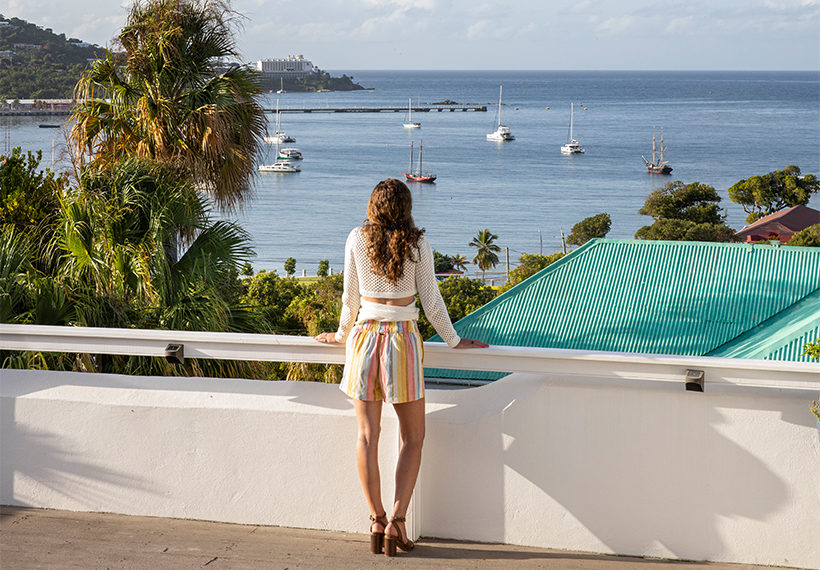
Day 1
A panoramic vista and a stroll through a colonial downtown on St. Thomas
The road climbing St. Peter Mountain zigs and zags past palms and chickens with places to go, and I thank God that Lou is driving and not me. As a former mason (a fitting occupation on St. Thomas, an island they call Rock City), he takes turns with, no doubt, the same precision he used to cut stone. And he doesn’t think cars are being driven on the wrong side. “We drive on the left, but have American cars with steering also on the left,” he says. “We are all mixed up!”
I consider how much this sounds like a metaphor for the U.S. Virgin Islands, a territory that’s been ruled under seven flags since Columbus, but soon we reach Mountain Top, a shop and bar where tourist kitsch (and spellbinding panoramas) shush such pondering. At the entrance, a giant Cruzan Rum bottle is besieged by life-size pirates dressed like the Village People. Out on the deck, some 2,100 feet above sea level, I meet Angela Payne, a guide from the tourism board, who puts names to the land masses out yonder: Puerto Rico, St. John (to which I’ll be taking a ferry tomorrow), and Magens Bay, with its white-sand beach and turquoise water. St. Croix, where I’ll be flying on day three, lies to the south, out of view. Scanning the fruit-bearing trees around us, she shakes her head and adopts what in the islands is a tone reserved for omens of bad weather. “Before Irma and Maria, the fruits—the mangoes!—were in such abundance. People saying, ‘Come, take my mangoes, please.’ It’s looking like that again, so it’s something on our minds.”
A sign above the bar boasts, “Home of the world famous banana daiquiri—7 million daiquiris sold,” and while it’s only 10 a.m., duty calls. A two-finger-deep lake of rum floats at the top of the glass, and Lou, sensing we could be in trouble if we go for round two, shuttles us back to the car and down the road toward the capital, Charlotte Amalie. On the way, we pass the wood-frame houses of Savan, a district carved out in the 1760s for free Africans and, later, waves of immigrants. Peckish, we stop at Weekes & Weekes Bakery for a Caribe classic: raisin bun and cheese, along with a bush tea, which Payne says is “made of whatever’s growing in the backyard!” This one tastes like lemongrass and mint.
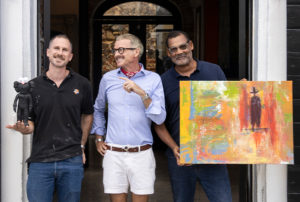
Wandering the historic center along the huge harbor, I imagine life in the 1700s, when the town was a frenetic hub for trading commodities at the docks and humans in the market squares. So great was the output of the slave population that sugar production from the three main islands bankrolled the entire kingdom of Denmark. Today, the stone commercial buildings in this neighborhood house shops and restaurants, and there’s an air of renewal. We stop in at 81C, an 1810 warehouse that Brooklyn transplant Zack Zook recently transformed into a gallery space that hosts weekly happenings.
“Downtown is revitalizing,” Zook says, “and we’re using the momentum to raise the bar in terms of things to do in the community. Our gallery is one of the more professional, in terms of art presentation, on all three islands, which says a lot about the potential here. People walk in and they’re impressed—many heavy hitters have visited and said it was amazing.” Abstract prints by Laurie Smithwick hang on the walls, and waiting in boxes are works by Puerto Rican painter Nel Figueroa. “We’re not too folky,” says Joseph Hewes, a partner. “We offer contemporary curation, as opposed to paintings of palm trees and starfish—no offense to starfish.”
“Being an entrepreneur on an island can be challenging,” Zook adds as he fiddles with the Wi-Fi and directs construction of the courtyard, a two-bedroom lodging, and a restaurant, where chef and painter Augustin Kelvin Holder will create the menu. “But St. Thomas is such a quirky, magical place, and so, so beautiful. It’s worth it.”
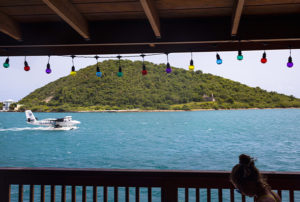
Filled with the magic of possibility, I focus on manifesting a delicious lunch, and soon I’m seated on the harbor patio of Petite Pump Room, filling my fork with blackened mahi-mahi and a buttery okra polenta called fungi. Calypso is playing, and on cue, like a Vegas fountain show, a seaplane fires up its propellers and takes off.
Hankering for a swim, I jump on a safari shuttle, the centaur of public transport— half open-air bus, half pickup truck. I jump out at Brewers Bay, handing the driver $1. The vibes on the beach are relaxed, with a Rasta playing “Redemption Song” on a flute and old men absorbed in games of dominoes. I wade into the clear, warm water, where turtles and stingrays swim around me without a care.
After a quick snooze under a palmetto tree, I grab a taxi back downtown, popping into Zora of St. Thomas, where an accomplished French horn player has been making custom sandals for 60 years. Wearing her trademark headscarf, tiny but fierce Zora Galvin is tracing a woman’s feet, stopping only to scold: “Don’t scrunch your toes, look straight, don’t look down.” A couple from Nebraska marvel at her every move. “We come for new ones every year,” one of them says, “even though they last forever.” Galvin lifts her hazel eyes, flattered but nonplussed.
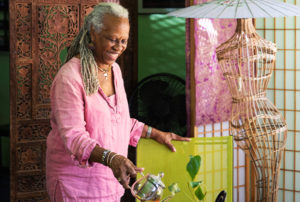
On the way up Government Hill toward my hotel, At Home in the Tropics B&B, I stop at a little green cottage, E’s Garden Teahouse, where owner Judith Watlington-Edwin, who has a magnificent head of gray dreads, tells me how a trip to China changed her life. “Seeing all the teahouses there, I thought, That might be a nice thing to do when I retire… and voilà!”
I finish my homegrown hibiscus tea and hunt down the island’s most famous “step-street,” 99 Steps—which everyone loves to point out has 103. Built from ballast bricks taken from ships, stairways such as this one offered an elegant solution to the problem of steep hills, and they remain in amazing condition, considering they’re about 270 years old.
After a quick shower, I’m sufficiently spruced up for a culinary treat at Blue Eleven, Ritz-Carlton-trained chef David Benjamin’s restaurant in the waterfront development Yacht Haven Grande.
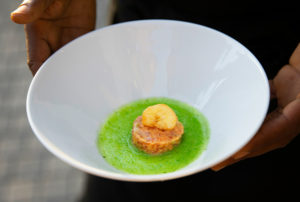
Given the choice of a 6-, 8-, or 11-course menu, I answer, “Yes, and the wine pairing.” With an open kitchen taking up nearly half the room, and Chef Benji, as he’s affectionately called, making the rounds, every table feels like the chef’s table.
When the small plates arrive, the heartbreak begins. The presentations are too beautiful, the flavors too captivating. Especially cruel is the butter-poached halibut with cassava foam and passion fruit butter. It leaves a scar on my heart. As I chat with my fellow diners, a refrain emerges: The room is filled with “Michelin-star foodies,” and this meal ranks among the best any of us has had.
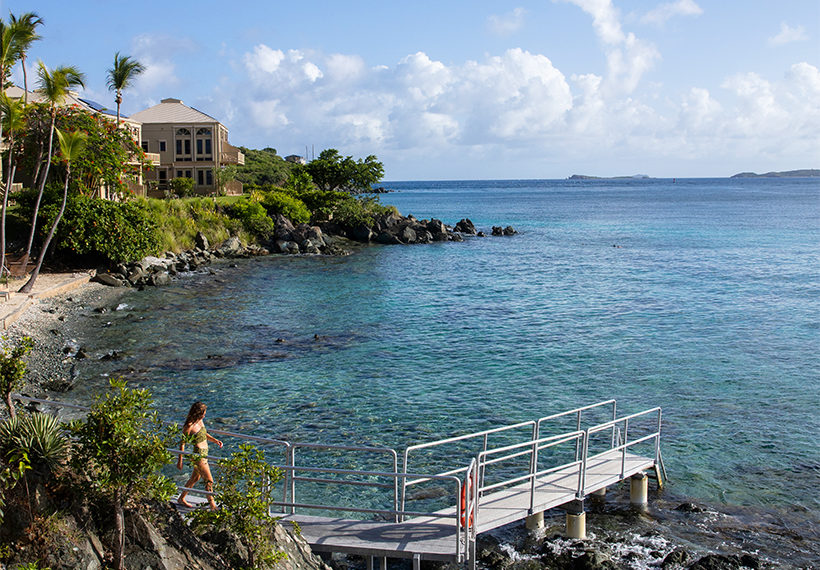
Day 2
Wildlife encounters and a rum tasting on St. John
A three-islands-in-three-days itinerary requires early wakeup calls, which dovetails nicely with one of my life goals: to always eat pastries hot out of the oven. Like Pepé Le Pew chasing his amour, I pursue croissants, and on my way to the ferry to St. John, I stop by Stir It Up coffee shop, where I get one with lemon butter and one with spinach and feta, plus a cinnamon roll that makes my heart skip a beat. By the time I reach the terminal, I’m halfway into its chewy perfection, so I slow my roll by ordering a coffee at the bar. The guy next to me orders a shot of Jäger. Good morning!
After a smooth 20-minute boat ride, we dock at Cruz Bay, a tiny commercial town that dates to the 1760s. The smallest of the three main islands, St. John is also the least developed, which is one reason they call it Love City. With so few residents, everyone knows everyone.
On top of that, thanks to a trip conservationist Laurance Rockefeller made here in the 1950s, more than half of the island’s 20 square miles are within Virgin Islands National Park. When the grandson of John D. Rockefeller saw the untouched beauty of the island, he pulled out his purse, buying more than 5,000 acres, which he then deeded to the government.
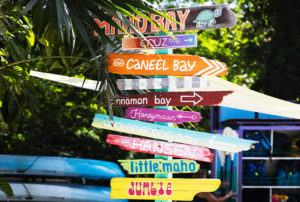
Excited to see Illuminati-approved nature, I set off to trek Reef Bay Trail, one of the park’s most challenging. Since it ends at a beach, I need to rent snorkeling gear. Not feeling up to navigating on the wrong side of the road, I’ve hired a driver for the day, Kenneth, who takes me to Maho Bay, where the girl at the Reef2Peak concession looks skeptical when I tell her what I’m doing. “You need one gallon of water minimum,” she says. “People get stuck out there climbing in the heat!” As I walk away, I can nearly hear her shake her head, so I keep it a secret that I’m three liters short.
Undeterred, I test the gear by swimming out to a patch of seagrass to find turtles. A hawksbill gives a dutiful wave, and a huddle of blue tangs look as though they’re gossiping, hopefully not about my water supply. Above water, pelicans dive for sushi. I want to stay, but I have to prove the lady, and possibly the fishes, wrong. Kenneth drives me up to the trailhead, and before I head out I ask if mongooses (mongeese?) live in the forest. “Yes,” he says, laughing, “but you won’t see one. They’re too fast!”
Starting at 900 feet above sea level, the trail drops quickly into the thick of a pristine forest that has never been cleared for plantations or charcoal mining. I’m thankful for the shade, compliments of the archipelago’s oldest Tyre palms, silk cottons, bromeliads, turpentines, genips, and hundreds more species.
From underneath a hand leaf bush, a primordial paw feels its way to the path, followed by a black shell with yellow spots—a land turtle! I’m about 1.5 miles in when I find a spur trail leading to a hidden spring-fed pool where Taino people carved petroglyphs into the basalt a millennium ago. Swarms of orange dragonflies dart about, their polyphonic buzzing synchronizing with the trickling waterfall. Feeling that it’s a sacred place, I make an offering of nuts and a coin and tiptoe out.
When I turn back around, I encounter a doe directly in front of me on the path. A sunbeam hits her crown, giving her a halo.
Back on the trail, I can’t shake the sense I’m being followed. When I swing around, I see the forest floor moving. Is this what the girl meant about people not making it out? An army of hermit crabs with meaty red limbs carrying their ridiculous shell houses are everywhere—on the ground, in the trees. It’s biblical. (I learn later that this is their great migration from forest to sea. En route, females discreetly lift their shells, allowing males to visit, then carry thousands of zygotes down the mountain. When the moms reach the shore, the crescent moon signals that it’s time to crawl into the water, at which point the eggs burst open.)
When I turn back around, I encounter a doe directly in front of me on the path. A sunbeam hits her crown, giving her a halo. Sensing I’m harmless, or that I have died, she goes back to sipping a puddle of rainwater by the ruins of a sugar mill. I stand so still I can hear the waves crashing on the shore.
When at last I reach the beach, there’s no sign of human life—no boats, no bad music. I dive in and swim over to the next beach, spotting stingrays, yellow puffers, and sea urchins I feel bad about wanting to eat.
Speaking of which, I’m starving by the time I finish the return hike. I ask Kenneth to take me somewhere only locals would go, and the next thing I know I’m out in the sticks, cutting into steamed Old Wife (it’s a fish) on a bed of seasoned rice at Heading East Bar & Grill. Co-owner John Griffith tells me how he went from driving a taxi to opening a restaurant next to a drive-in movie theater during a pandemic. “It wasn’t easy, but we did it, little by little,” he says. I also take a shot of Mama Juana, a spiced guavaberry rum and alleged cure-all, and learn an island toast: “It’s a great day, another one!”
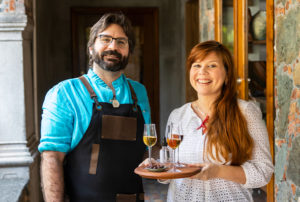
Heading west to Cruz Bay, I stop at the Mongoose Junction shopping center, taking time to admire the flamboyant bricolage-style masonry. (Lou, my driver in St. Thomas, cut the stone.) On the ground floor, I walk into Bajo el Sol, an art gallery/rum room, where owner Priscilla Hintz Rivera Knight becomes my rum shaman, guiding me toward redemption with sips of single-estate, small-batch, reserve, and vintage rums from Jamaica, Martinique, Haiti, Barbados, and more. “As Caribbean people, we are born with a little rum in our bellies,” she says. We finish with a delicious iced latte made with chai-infused rum crafted by writer V.S. Naipaul’s nephew in Trinidad.
Before calling it a night at my hotel, the Gallows Point Resort, I opt for a tropical classic: a catamaran cruise, garnished with a sunset. The all-female Cruz Bay Watersports crew sails the boat around Pillsbury Sound, where the Atlantic and Caribbean basins meet and a volcanic blast gave birth to the archipelago. In between canapés, I raise a glass to my lucky stars.
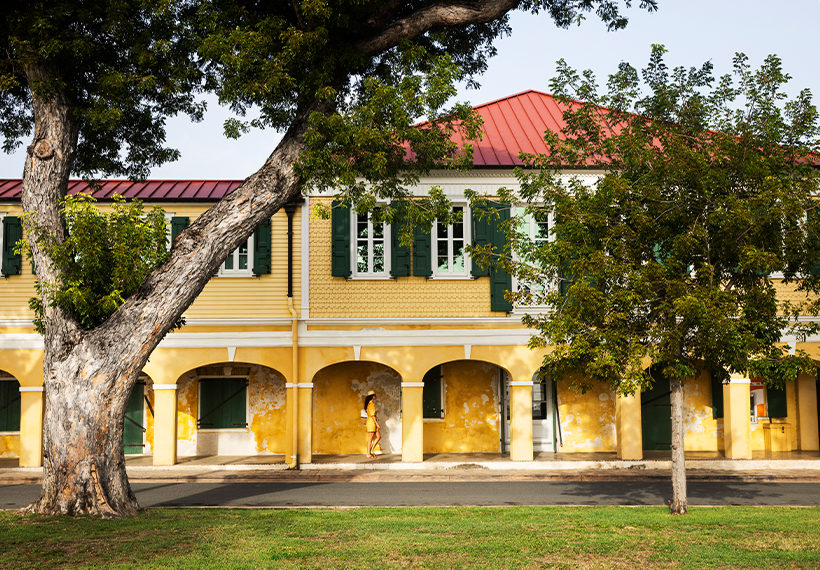
Day 3
A finger-licking-good food tour and a bioluminescent bay on St. Croix
At dawn I take the ferry back to St. Thomas to catch a seaplane to St. Croix. From the sky, my destination looks triple the size of St. Thomas, trading volcanic hills for grassy flats. At the dock, I meet my friend Sharon, also a guide, and John, my new driver, who takes us for “an island breakfast” at Martha’s Deli, a hole in the wall where there’s a line before the door even opens.
Soon I’m presented with a platter of Crucian delights: saltfish, chop-up (chopped spinach and okra), cucumber salad, a banana fritter, and a johnnycake—a warm disc of salty-sweet fried bread that Crucians argue about the way Italians argue about pasta. Taking a bite is an invitation to the past. “Enslaved Africans ate them on their way to the fields in the morning,” Sharon says. “They called them ‘journey cakes,’ which over time became ‘johnnycakes.’”
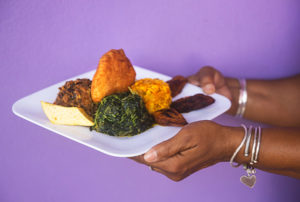
Satiated, we continue west to Frederiksted, the younger of the towns that give the island its nickname, Twin City. Locals call Frederiksted “Freedom City” after a slave rebellion here—signaled by a long blow into a conch shell—led to emancipation in the Danish West Indies in 1848. Thirty years later, four women led a labor revolt, setting the island ablaze. Afterward, the cities were rebuilt in the Victorian gingerbread style of the day and painted the colors of the Caribbean.
“Until recently, we had one of the largest oil refineries in the Western Hemisphere,” Sharon says, “so we didn’t depend on tourism dollars.” That, and a self-sustaining agricultural economy, allowed the island the space to cultivate a multiethnic, festival-oriented culture with its own music, food, jewelry, and vibe.
Along the shore, we wander into the Caribbean Museum Center for the Arts. Upstairs is an exhibition by Chalana Brown, who photographed old sugar mills and, in her research, traced her ancestry to several plantations. “Sugar mills are why African bodies are in the Caribbean,” she says, “but we avoid them, as we battle colonial trauma. I say we reclaim them, reconcile with them, and tell an alternative narrative about ourselves.”
‘St. Croix is the culinary gateway to the Caribbean,’ says Anquanette Gaspard, owner of Virgin Islands Food Tours.
Next, we stop at a small beach where a few older folks with floppy hats are wading in the water, their giggles as soothing as wind chimes. After a quick dip, it’s on to Christiansted, where Anquanette Gaspard, owner of Virgin Islands Food Tours, is set to help us explore the island’s famous food scene. “St. Croix is the culinary gateway to the Caribbean,” she says. The culinary traditions here were influenced not only by Africa and Denmark during the colonial era, but also by immigrants who came from neighboring islands throughout the 20th century.
Our first two bites come thanks to the old Hess oil refinery, which drew workers from Trinidad in the 1970s. Some of those people opened restaurants, such as Singh’s Fast Food, where we have fried bread with curried potatoes, chickpeas, and pepper sauce. At Gary’s Bakery & Deli, a coconut drop has just the right amount of earthy sweetness.
Zeny’s, an eatery in the living room of a yellow clapboard house, traces its roots to different islands—Puerto Rico and the Dominican Republic. We devour stewed chicken with seasoned rice, beans, and sweet plantains, and then head to Ital in Paradise, where we try a crispy lentil ball dipped in a tangy sauce made from local peppers and passion fruit, along with a peanut punch that’s somehow both creamy and refreshing.
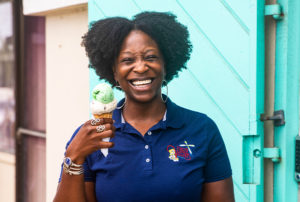
As we walk down East Street, Gaspard points out images of costumed figures on stilts appearing on murals, jewelry, dolls, dashboards. “We say, when Moko Jumbies are near, evil is far,” she tells me. “They are protectors. At festivals and parades, they’re always there dancing, twisting, doing all kinds of moves on their stilts.” We continue toward the fort where a young Rachel Faucette, the future mother of Alexander Hamilton, was jailed for adultery. Riding a chorus of shouts of “Mornin’!”—you mustn’t pass a person without a greeting here—we get pineapple ice cream at What’s Da Scoop and pause to watch a couple press a stalk of sugarcane under a tree. “It’s a bolt of energy!” they say, offering a cup of the juice. As if I need an excuse to try.
Built to shade Danish ladies as they shopped, the roofed galleries of the historic buildings here are ingeniously practical, but they also lend a genteel flair that suits today’s ladies, done up in heels, hats, and stacks of handmade silver and gold “hook” bracelets sparking in the sun. Each designer has her own take, but the meaning of the hook’s position is constant: pointed at your heart, you’re taken; pointed outward, you’re open for love. If I had a hook, it would be pointed at my stomach, because I’m a shameful glutton who’s about to have another meal, at La Reine Chicken Shack. “One thing we do around here is eat,” Sharon says as we sit at an outdoor table decked with oxtail stew, ribs, and juicy rotisserie chicken cooked over wood-chip coal. “Not because we’re hungry—it’s just what we do.”
It’s time for something active, so John drives me to BushTribe Eco Adventures for a paddle in the bioluminescent Salt River Bay. After the sun vanishes, my guide, Chris, and I venture out into the bay. Awesome streaks of blue light appear when the tiny creatures in the water are disturbed. Chris reaches into the water and grabs a glowing ball. “It’s a Ctenophore,” he says. “Want to feel it? It’s slimy!” I hold the little gelatinous body and watch it dim. “When they get tired, they lose their glow,” he notes. I can relate.
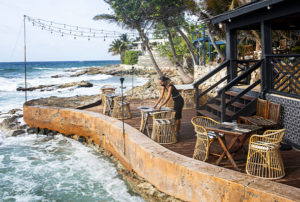
On the drive to my hotel, Waves Cane Bay, John tells me that his wife makes him hot soursop tea before bed. “I sleep the whole night through!” he says. “It’s so wonderful!” I bid him good night, knowing I’ll see him again soon—at 4:45 a.m., to catch the sunrise at Point Udall, the easternmost place in the U.S., before my flight home. Since I don’t have any soursop tea, I get a nightcap at the hotel’s restaurant, Ama, which is perched above a tidal pool where waves constantly thrash against the rocks.
The sound of those waves makes it easy to rise just a few hours later. John whisks me to the point, where we join about a dozen people waiting for the sun. Not just tourists, either: Local DJ Swain is stretched out on the hood of his truck, which, conveniently, bears his name on the side. As we become the first people in America to welcome a new day, John hands me a bag of soursop leaves to brew at home, so that I too may sleep the whole night through. No doubt, I’ll be dreaming of this magic place.
Escape the Cold in “America’s Paradise”: United flies nonstop between St. Thomas and Chicago O’Hare, Houston Intercontinental, New York/ Newark, and Washington Dulles.
